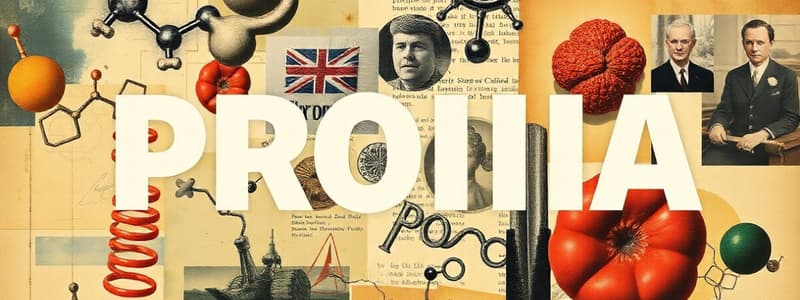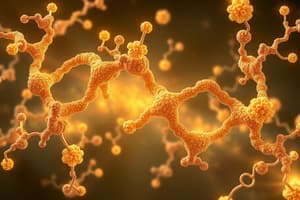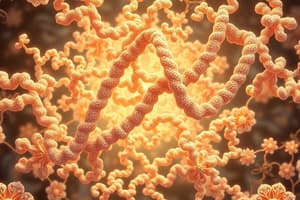Podcast
Questions and Answers
Which type of protein is characterized by a spheroidal shape?
Which type of protein is characterized by a spheroidal shape?
- Conjugated proteins
- Fibrous proteins
- Globular proteins (correct)
- Derived proteins
All proteins are classified based on their amino acid content only.
All proteins are classified based on their amino acid content only.
False (B)
What term describes proteins that consist solely of amino acids?
What term describes proteins that consist solely of amino acids?
Simple proteins
Hemoglobin is an example of a ______ protein.
Hemoglobin is an example of a ______ protein.
Match the following types of proteins with their examples:
Match the following types of proteins with their examples:
Which of the following classifications of proteins has a prosthetic group?
Which of the following classifications of proteins has a prosthetic group?
Name a type of protective protein.
Name a type of protective protein.
Which of the following is a nutritionally rich protein?
Which of the following is a nutritionally rich protein?
Incomplete proteins can promote body growth in young individuals.
Incomplete proteins can promote body growth in young individuals.
What are metaloproteins?
What are metaloproteins?
Proteins from pulses are deficient in __________.
Proteins from pulses are deficient in __________.
Match the following types of proteins with their characteristics:
Match the following types of proteins with their characteristics:
What is the primary function of proteolytic enzymes?
What is the primary function of proteolytic enzymes?
Cooking dietary proteins enhances their digestibility.
Cooking dietary proteins enhances their digestibility.
What are endopeptidases and give an example?
What are endopeptidases and give an example?
A diet based on __________ proteins will not even sustain the original body weight.
A diet based on __________ proteins will not even sustain the original body weight.
What is the role of hydrochloric acid in protein digestion?
What is the role of hydrochloric acid in protein digestion?
Rennin, also known as chymosin, is present in adults and is involved in curdling milk.
Rennin, also known as chymosin, is present in adults and is involved in curdling milk.
What is the optimum pH for the activity of pepsin?
What is the optimum pH for the activity of pepsin?
____ are the endopeptidases present in pancreatic juice.
____ are the endopeptidases present in pancreatic juice.
Match the following enzymes to their respective functions:
Match the following enzymes to their respective functions:
What stimulates the secretion of pancreatic juice?
What stimulates the secretion of pancreatic juice?
Acute pancreatitis is caused by the premature activation of trypsinogen inside the pancreas.
Acute pancreatitis is caused by the premature activation of trypsinogen inside the pancreas.
What is the function of aminopeptidase in protein digestion?
What is the function of aminopeptidase in protein digestion?
Pepsinogen is converted to pepsin by the action of ____.
Pepsinogen is converted to pepsin by the action of ____.
Which enzyme is responsible for curdling milk in infants?
Which enzyme is responsible for curdling milk in infants?
The optimum pH for activity of pancreatic enzymes is around 8.
The optimum pH for activity of pancreatic enzymes is around 8.
What is the role of carboxypeptidase in protein digestion?
What is the role of carboxypeptidase in protein digestion?
Pepsinogen is converted to pepsin by the action of __________.
Pepsinogen is converted to pepsin by the action of __________.
Match the enzymes with their primary action:
Match the enzymes with their primary action:
Which hormone stimulates the secretion of pancreatic juice?
Which hormone stimulates the secretion of pancreatic juice?
Pepsin functions optimally at a high pH level above 7.
Pepsin functions optimally at a high pH level above 7.
What is the function of pancreatic elastase?
What is the function of pancreatic elastase?
Chymotrypsin is activated by trypsin.
Chymotrypsin is activated by trypsin.
What enzyme is responsible for degrading small peptides into amino acids?
What enzyme is responsible for degrading small peptides into amino acids?
Chymotrypsinogen is activated to chymotrypsin by __________.
Chymotrypsinogen is activated to chymotrypsin by __________.
Match the following enzymes with their functions:
Match the following enzymes with their functions:
What is the role of carboxypeptidases?
What is the role of carboxypeptidases?
Pancreatic enzymes are affected by changes in intestinal transit time.
Pancreatic enzymes are affected by changes in intestinal transit time.
What type of enzyme acts on peptide bonds inside the protein molecule?
What type of enzyme acts on peptide bonds inside the protein molecule?
Proteolytic enzymes are secreted in their active form to prevent autodigestion of the secretory acini.
Proteolytic enzymes are secreted in their active form to prevent autodigestion of the secretory acini.
What metal is required by carboxypeptidases for their activity?
What metal is required by carboxypeptidases for their activity?
What is the role of pepsin in protein digestion?
What is the role of pepsin in protein digestion?
This condition is characterized by the destruction of __________ cells, leading to serious health issues.
This condition is characterized by the destruction of __________ cells, leading to serious health issues.
The activation of trypsin occurs in the __________.
The activation of trypsin occurs in the __________.
Match the following pancreatic enzymes with their primary functions:
Match the following pancreatic enzymes with their primary functions:
Which of the following statements is true regarding the effect of pH on enzyme activity?
Which of the following statements is true regarding the effect of pH on enzyme activity?
Pepsin functions optimally in a basic pH environment.
Pepsin functions optimally in a basic pH environment.
What occurs during the denaturation of dietary proteins when cooking?
What occurs during the denaturation of dietary proteins when cooking?
Proteins derived from __________ are deficient in lysine.
Proteins derived from __________ are deficient in lysine.
Study Notes
Protein Classification
- Proteins can be classified based on their shape, function, solubility, and nutritional value.
- Globular proteins are spherical in shape and include plasma albumins, globulins, and many enzymes.
- Fibrous proteins have a long, thin structure and include keratin, myosin, fibrin, and collagen.
- Catalytic proteins are enzymes that accelerate biochemical reactions.
- Structural proteins provide support and shape to cells and tissues, examples include collagen, elastin, and keratin.
- Contractile proteins are responsible for muscle movement, examples include myosin and actin.
- Transport proteins carry molecules throughout the body, examples include hemoglobin, myoglobin, albumin, and transferrin.
- Regulatory proteins or hormones control and regulate biological processes, examples include ACTH, insulin, and growth hormone.
- Genetic proteins are involved in the storage and transmission of genetic information, examples include histones.
- Protective proteins defend the body against disease and injury, examples include immunoglobulins and clotting factors.
- Simple proteins consist solely of amino acids with small amounts of carbohydrates, including albumins, globulins, protamine, glutelin, and scleroprotein.
- Conjugated proteins are composed of a protein component and a non-protein component called a prosthetic group. Examples include glycoproteins, lipoproteins, nucleoproteins, chromoproteins, phosphoproteins, and metalloproteins.
- Glycoproteins combine proteins with carbohydrates, examples include blood group antigens and serum proteins.
- Lipoproteins combine proteins with lipids, found in blood and cell membranes.
- Nucleoproteins are proteins bound to nucleic acids, example include histones.
- Chromoproteins contain colored prosthetic groups, examples include hemoglobin, flavoproteins, and visual purple.
- Phosphoproteins contain phosphorus, examples include casein of milk and vitellin of egg yolk.
- Mettaloproteins contain metal ions, examples include hemoglobin, cytochrome, tyrosinase, and carbonic anhydrase.
- Derived proteins are breakdown products of native proteins, created through hydrolysis of protein chains.
- Nutritionally rich proteins are also called complete proteins or first-class proteins, They provide all essential amino acids in the required proportions, supporting growth in young individuals. Examples include casein from milk.
- Incomplete proteins lack one or more essential amino acids. They don't support growth in young individuals but can sustain body weight in adults. Examples include proteins from pulses (lack methionine) and cereals (lack lysine).
- Poor proteins lack many essential amino acids and cannot even sustain body weight. Example includes zein from corn (lacks tryptophan and lysine).
Protein Digestion
- The digestion of dietary proteins starts in the stomach and continues in the small intestine.
- Proteolytic enzymes break down protein molecules by hydrolyzing peptide bonds. They are secreted as inactive zymogens and converted to active forms in the intestinal lumen to prevent autodigestion of secretory acini.
- Endopeptidases cleave peptide bonds within the protein molecule. Example include pepsin, trypsin, and chymotrypsin.
- Exopeptidases act on peptide bonds at the ends of the protein chain. Examples include carboxypeptidase (carboxyl terminal end) and aminopeptidase (amino terminal end).
- Gastric secretion includes:
- Hydrochloric acid: denatures proteins, creates optimal pH for pepsin activity, and activates pepsinogen to pepsin.
- Rennin (chymosin): curdles milk in infants by converting casein to paracasein, making it easier for pepsin to digest.
- Pepsin: secreted as inactive pepsinogen from chief cells, activated by hydrochloric acid, an endopeptidase that breaks proteins into proteoses.
- Pancreatic secretion: occurs at optimal pH of 8, provided by bile and pancreatic juice. Enzymes include:
- Trypsin: activated from trypsinogen by enterokinase, breaks down bonds formed by carboxyl groups of arginine and lysine. Premature activation in the pancreas can lead to acute pancreatitis, a life-threatening condition.
- Elastase: hydrolyzes bonds formed by carboxyl groups of alanine, glycine, and serine. Not degraded in intestinal transit and can be measured in stool samples to indicate pancreatic health.
- Chymotrypsin: activated from chymotrypsinogen by trypsin, degrades proteoses into smaller peptides.
- Carboxypeptidases: metalloenzymes requiring zinc, further hydrolyze small peptides into dipeptides and tripeptides.
- Intestinal secretion: completes the digestion of small peptides into amino acids using enzymes present in intestinal juice. Aminopeptidases on intestinal epithelial cells release N-terminal amino acids.
Protein Digestion
- Carboxypeptidase breaks down peptides at the carboxyl terminal end.
- Aminopeptidase breaks down peptides at the amino terminal end.
- Digestion of proteins occurs through secretions from the stomach, pancreas, and intestines.
Gastric Secretions
- Hydrochloric acid denatures proteins, kills bacteria, activates pepsin, and optimizes pH for pepsin activity.
- Rennin, also known as chymosin, curdles milk in infants.
- Pepsin, secreted as inactive pepsinogen, is activated by hydrochloric acid and breaks down proteins into proteoses.
Pancreatic Secretions
- Pancreatic juice is stimulated by the hormones cholecystokinin and pancreozymin.
- The optimal pH for pancreatic enzymes is 8, provided by alkaline bile and pancreatic juice.
- Trypsin, activated by enterokinase, breaks down peptide bonds formed by arginine and lysine. Premature activation of trypsinogen can lead to acute pancreatitis.
- Elastase breaks down peptide bonds formed by alanine, glycine, and serine. It is not degraded in the intestines and its levels can be measured in stool samples.
- Chymotrypsin, activated by trypsin, degrades proteoses into smaller peptides.
- Carboxypeptidases are metalloenzymes that break down small peptides into dipeptides and tripeptides.
Intestinal Secretions
- Aminopeptidases in intestinal juice further digest peptides into amino acids.
Protein Classification
- Proteins can be classified based on shape, function, solubility, and nutritional value.
Shape
- Globular proteins are spheroidal and include plasma albumins, globulins, and many enzymes.
- Fibrous proteins have elongated structures and include keratin, myosin, fibrin, and collagen.
Function
- Catalytic proteins include enzymes.
- Structural proteins include collagen, elastin, and keratin.
- Contractile proteins include myosin, actin, and flagellar proteins.
- Transport proteins include hemoglobin, myoglobin, albumin, and transferrin.
- Regulatory proteins or hormones include ACTH, insulin, and growth hormone.
- Genetic proteins include histones.
- Protective proteins include immunoglobulins and clotting factors.
Solubility
- Simple proteins consist only of amino acids (with small amounts of carbohydrates) and include albumins, globulins, protamines, scleroproteins, and glutelins.
- Conjugated proteins are proteins combined with a non-protein prosthetic group and include:
- Glycoproteins (proteins + carbohydrates)
- Lipoproteins (proteins + lipids)
- Nucleoproteins (proteins + nucleic acids)
- Chromoproteins (proteins + colored prosthetic groups)
- Phosphoproteins (proteins + phosphorus)
Nutritional Value
- Nutritionally rich proteins or complete proteins contain all essential amino acids in required proportions.
- Incomplete proteins lack one or more essential amino acids.
- Poor proteins lack many essential amino acids.
Protein Catabolism
- Protein catabolism refers to the breakdown of proteins.
- This occurs with both dietary and body proteins.
Dietary Protein Digestion
- Cooking denatures proteins, making them easier to digest.
- Proteolytic enzymes, such as pepsin, trypsin, and chymotrypsin, break down peptide bonds.
- They are secreted as inactive zymogens, to prevent autodigestion.
Proteolytic Enzyme Classification
- Endopeptidases break down peptide bonds within the protein molecule.
- Exopeptidases break down peptide bonds at the ends of the protein chain.
Studying That Suits You
Use AI to generate personalized quizzes and flashcards to suit your learning preferences.
Related Documents
Description
Test your knowledge on the classification of proteins based on their shape, function, solubility, and nutritional value. This quiz covers various types of proteins, including globular, fibrous, and contractile proteins, among others. Challenge yourself to understand the diverse roles of proteins in biological processes.




